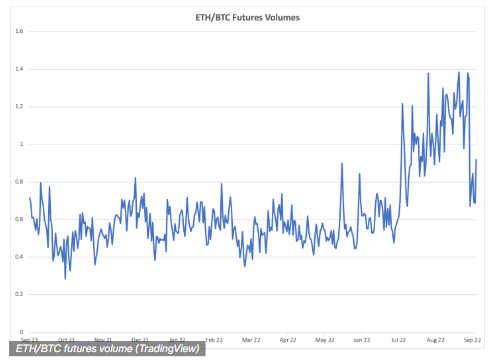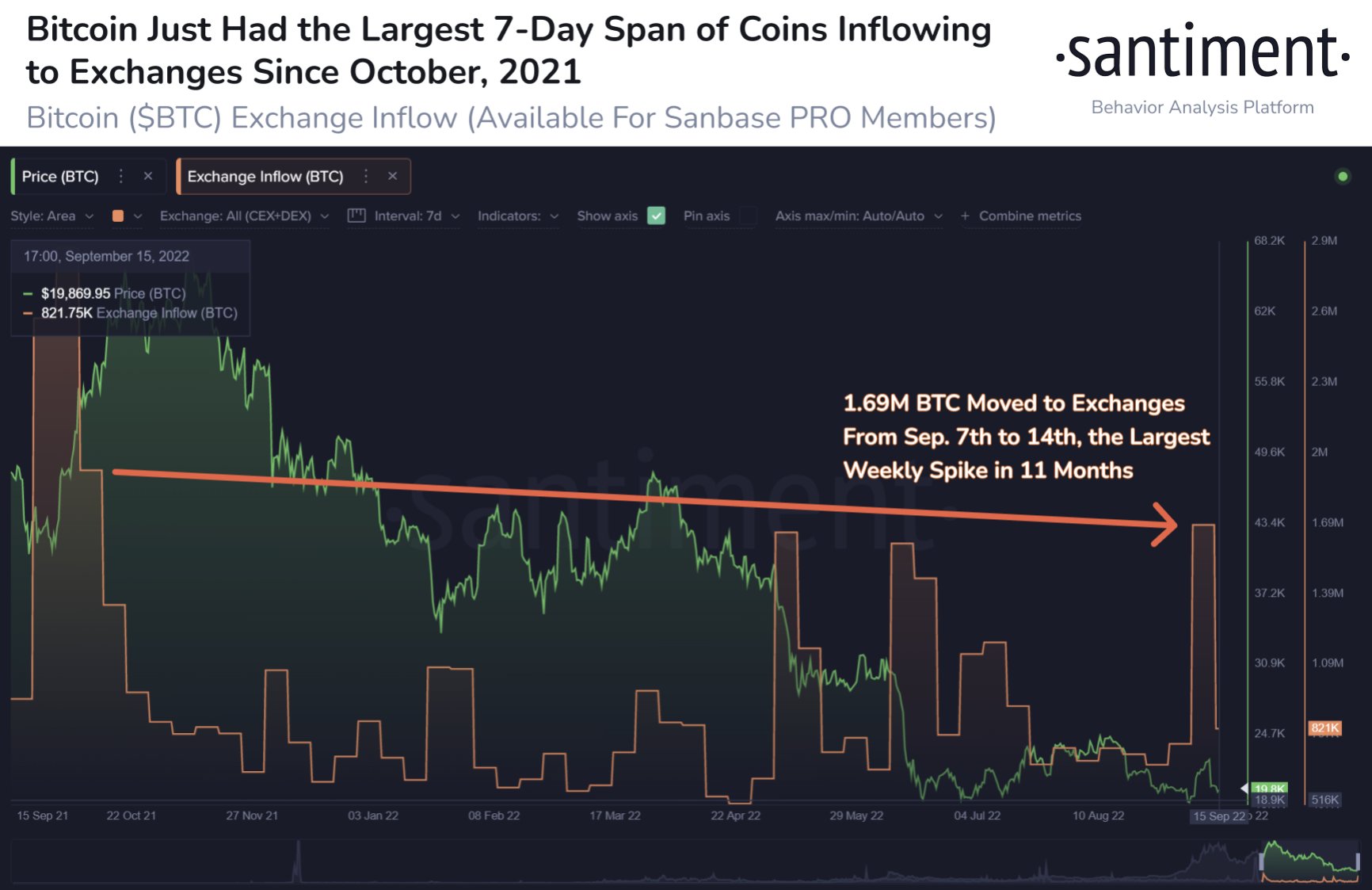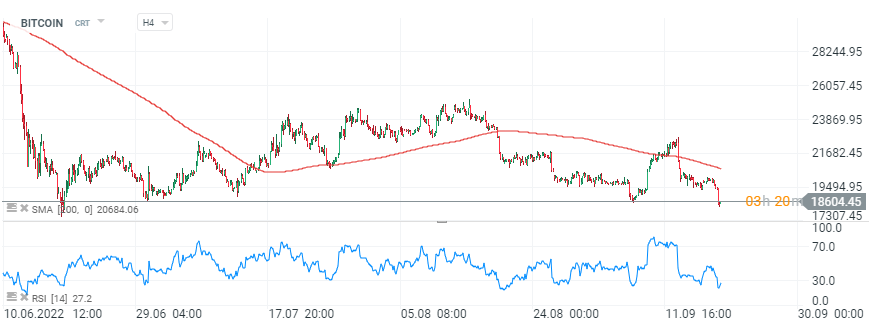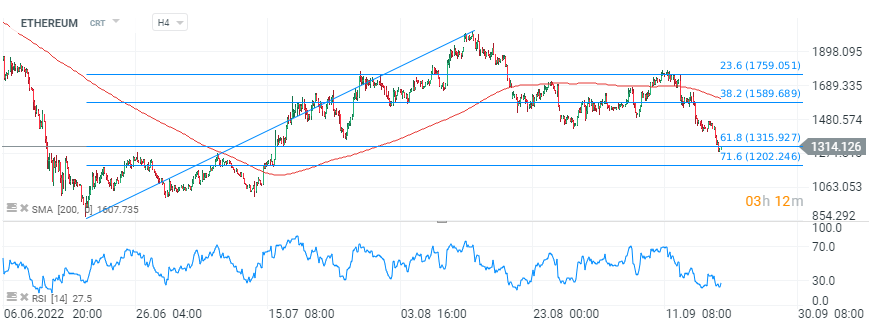Cryptocurrencies cannot resist the negative sentiment prevailing in the stock market. Markets are still 'spooked' by the Fed decision, which we will learn on Wednesday. The market capitalization has once again fallen below $1 trillion:
- Bitcoin has settled below $18,500 which fills with concern, the largest cryptocurrency is approaching the June price lows again. Dominance vis-à-vis the king of cryptocurrencies is also losing ground to 'sinking' Ethereum, which has already lost nearly 25% since the Merge and is trading below $1,300 per token;
- Digital assets are exposed to particularly high volatility because record amounts of money flowed into cryptocurrencies during a period of frivolous monetary policy. Now we see a completely opposite trend, monetary policy is weighing down cryptocurrency valuations mightily;
- Merge turned out not to be a short-term catalyst for growth, and market participants apparently perceived the lack of growth after Ethereum's successful transition as a sell signal according to the principle 'if it's so good, and yet the price doesn't want to grow it's a sign that it will fall';
- Despite Ethereum's disrupted growth 'under Merge', we can see the event today as a 'selling fact'. Head of Digital Assets at VanEck, Matthew Sigel reassures investors and stresses that investors need the network to achieve stability and similar events in the past (Bitcoin's halving) also passed without an echo though, and eventually turned out to have a key impact on the price increase on the price. At the same time, Sigel expects Ether to be valued at $8,000 over a 5-year horizon, and more important than the price reaction is the fact that the merge was successful, which will be recognized sooner or later;
- Analysts point to the progressive 'centralization' of Etheruem, with 2/3 of the supply controlled by the 7 largest token holders with 46.15% of the nodes in the new network controlled by only two addresses (probably Lido and Coinbase);
- According to Bitstamp USA CEO Bobbe Zagotta, institutions were mainly responsible for the price rally under 'The Merge' (56% volume growth among institutional investors), retail investors were not so eager to trade (about 38% volume growth), which is a good indication of the melting by inflation of financial capacity and risk aversion among the so-called 'retail', which in 2021 represented a powerful 'competition' for institutional investors in the swelling cryptocurrency market;
- The Ripple community is hoping for a near end to its dispute with the U.S. Securities and Exchange Commission (SEC), which in 2020 accused Ripple of selling $1.3 million worth of unregistered XRP tokens accusing the company of failing to comply with exchange regulations. Ripple entered into a lawsuit with the SEC that has been pending for more than two years, however, both sides asked a New York court on September 17 for summary judgment on an expedited basis. A judge has been called in to decide whether Ripple's sale of cryptocurrencies violated US stock trading regulations;
- Ripple CEO Brad Garlinghouse is still confident in Ripple's success, and insists that the SEC exceeded the authority given to it by Congress by wanting to regulate an industry not under it. Indeed, in the course of the trial against the decision, material from both members and the former head of the SEC has been collected that is sinking into the position. U.S. Attorney Jeremy Hogan indicated that the circumstances of the trial were appropriate for the court to grant summary judgment;
- The court's decision could be significant for the entire industry and foreshadow the US position on cryptocurrencies because it could set a so-called precedent for future rulings on similar cases;
- The market circulated the position of the head of the SEC, Gary Gensler whose opinion is that cryptocurrencies operating as Proof of Stake meet the conditions to be treated as securities. According to Gensler, Ethereum's 'staking' profits resemble a reverse lending system and fit well with the financial nature of cryptocurrency in which users lend their resources in exchange for rewards paid in ETH. The Ripple decision may shed some more light on possible future regulation of Ethereum'.
![]()
Bitcoin's fall below $19,000 resulted in record liquidations of long positions. The total loss of traders on centralized exchanges amounted to more than $431 million. Bitcoin traders' losses nearly exceeded those of Ethereum traders by a factor of five, amounting to $44.5 million compared to nearly $8.4 million for Ethereum. In the past, such large liquidations have sometimes heralded an impending change in sentiment. Source: Coinglass
Start investing today or test a free demo
Create account Try a demo Download mobile app Download mobile appThe volume of futures contracts on the ETH/BTC pair fell after Ether's dominance declined following the negative price reaction in 'The Merge' results. So it looks like the 'flippening' won't happen as soon as ETH fans wished. Source: Skew.com, TradingView.
 Between September 7 and 14, record amounts of Bitcoin hit the balances of centralized exchanges, which tended to indicate growing supply pressure (whales' desire to liquidate reserves). The total impact of 1.69 million Bitcoins represents about 8% of the total available supply of cryptocurrency. At the same time, this is the highest number of weekly BTC transfers to exchanges in nearly 11 months. Such a significant inflow may herald a deeper weakening of Bitcoin and the willingness of large investors to hedge against possible depreciation risks in the context of the upcoming Fed meeting. The transfer was directly related to the Ethereum Merge, which took place on September 15, and likely confirms that large addresses were behind the recent sell-off in the cryptocurrency market, which historically is not a positive sign. Source: Santiment
Between September 7 and 14, record amounts of Bitcoin hit the balances of centralized exchanges, which tended to indicate growing supply pressure (whales' desire to liquidate reserves). The total impact of 1.69 million Bitcoins represents about 8% of the total available supply of cryptocurrency. At the same time, this is the highest number of weekly BTC transfers to exchanges in nearly 11 months. Such a significant inflow may herald a deeper weakening of Bitcoin and the willingness of large investors to hedge against possible depreciation risks in the context of the upcoming Fed meeting. The transfer was directly related to the Ethereum Merge, which took place on September 15, and likely confirms that large addresses were behind the recent sell-off in the cryptocurrency market, which historically is not a positive sign. Source: Santiment
Bitcoin chart, H4 interval. The price of the major cryptocurrency has settled below $19,500 and is rebounding from levels at $18,500. The durability of the current rebound may determine whether Bitcoin will not break through the June minima again. The RSI is indicating levels close to oversold which may suggest an increasingly narrow downside range. On the other hand, a huge drop below the 200-session average on the four-hour interval, which runs at $20,600, could herald further, deeper weakness in the price. We can expect more volatility on Wednesday, when the Fed's decision on the amount of the next rate hike will be known at 8pm. So far, Bitcoin's initial reactions to Fed decisions have usually been positive. Until then, a consolidation in the $18,500 to $19,500 range is likely. Source: xStation5 Ethereum chart, H4 interval. The cryptocurrency is in an almost twin situation to Bitcoin. Ether is more than 20% short of its 200-session average at $1,600, which 'swelled' during the rally under the merge. The price has stopped at the 61.8 Fibonacci retracement from where it is trying to reverse the cascading sell-off. Source: xStation5
Ethereum chart, H4 interval. The cryptocurrency is in an almost twin situation to Bitcoin. Ether is more than 20% short of its 200-session average at $1,600, which 'swelled' during the rally under the merge. The price has stopped at the 61.8 Fibonacci retracement from where it is trying to reverse the cascading sell-off. Source: xStation5
This content has been created by XTB S.A. This service is provided by XTB S.A., with its registered office in Warsaw, at Prosta 67, 00-838 Warsaw, Poland, entered in the register of entrepreneurs of the National Court Register (Krajowy Rejestr Sądowy) conducted by District Court for the Capital City of Warsaw, XII Commercial Division of the National Court Register under KRS number 0000217580, REGON number 015803782 and Tax Identification Number (NIP) 527-24-43-955, with the fully paid up share capital in the amount of PLN 5.869.181,75. XTB S.A. conducts brokerage activities on the basis of the license granted by Polish Securities and Exchange Commission on 8th November 2005 No. DDM-M-4021-57-1/2005 and is supervised by Polish Supervision Authority.


